| ________________
CM . . .
. Volume XI Number 11 . . . .February 4, 2005 
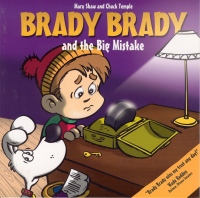 |
Brady Brady and the Big Mistake.
Mary Shaw. Illustrated by Chuck Temple.
Waterloo, ON: Brady Brady Inc., 2001/2004.
32 pp., pbk., $6.99.
ISBN 0-9735557-4-2.
Preschool-grade 2 / Ages 4-7.
Review by Dave Jenkinson.
**** /4
excerpt:
It was the perfect afternoon for a game of shinny - and the perfect place was Brady's backyard
rink.
Brady shoveled off the ice rink and put out the nets. He wanted everything to be just right for his
friends.
That's when the idea hit him. (From Brady Brady and the Big Mistake.)
|
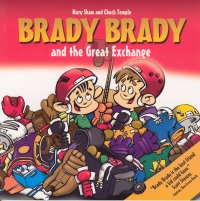 |
Brady Brady and the Great Exchange.
Mary Shaw. Illustrated by Chuck Temple.
Waterloo, ON: Brady Brady Inc., 2003/2004.
32 pp., pbk., $6.99.
ISBN 0-9735557-5-0.
Preschool-grade 2 / Ages 4-7.
Review by Dave Jenkinson.
**** /4
excerpt:
As Gregory began to pack up his equipment bag, Brady noticed his red, puffy feet. Gregory had
stopped wearing his tie-dyed socks a month ago. His teammates had found this strange because
Gregory had always claimed that the thick, green socks were his good luck charm. Now Brady
knew what was wrong. (From Brady Brady and the Great Exchange.)
|
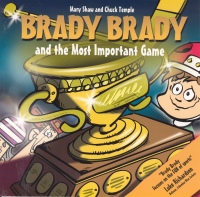 |
Brady Brady and the Most Important Game.
Mary Shaw. Illustrated by Chuck Temple.
Waterloo, ON: Brady Brady Inc., 2004.
32 pp., pbk., $6.99.
ISBN 0-9735557-6-9.
Preschool-grade 2 / Ages 4-7.
Review by Dave Jenkinson.
***1/2 /4
excerpt:
Not only was this the biggest tournament of the season, it was being played at the Icehogs' home rink.
The Icehog players put up posters all over town to let everyone know about the important weekend.
Brady had been counting the days until the big weekend arrived. The night before the tournament, Brady was so excited, he slept in his equipment.
He dreamt about racing up the ice on a breakaway, sparks flying from his skates, and scoring the tournament-winning goal. (From Brady Brady and the Most Important Game.)
|
| |
|

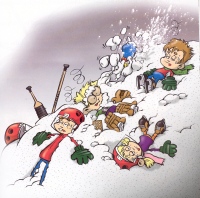 Brady Brady had played only a few periods of hockey when his publisher, Stoddart, went out of
business, but now he and his fellow Icehogs are back on the ice with their own publishing house,
Brady Brady Inc. As in the earlier Stoddart volumes, Brady and his teammates are dealing with
matters than loom large in the minds of young children. In Brady Brady and the Big Mistake,
Brady, without permission, borrows his father's treasured possession, a puck autographed by the
legendary Bobby Orr. While it was initially only Brady's intention to show the puck to his friends,
it becomes the one they use in a game of shinny on Brady's backyard rink. Unfortunately, Brady's
wrist shot flies over the net, and the puck disappears into a huge snowbank. Everyone searches
for the puck but with no success, and, when Brady's father comes home, the young lad must
confess what he has done. Although Brady's father does express some disappointment in his son's
initial action, he expresses his pride in Brady's "telling me the truth about what happened." While
the text doesn't say so directly, the book has a happy ending for Temple's closing illustration
shows Hatrick, Brady's dog, standing in his doghouse, the missing puck clamped in his jaws. Brady Brady had played only a few periods of hockey when his publisher, Stoddart, went out of
business, but now he and his fellow Icehogs are back on the ice with their own publishing house,
Brady Brady Inc. As in the earlier Stoddart volumes, Brady and his teammates are dealing with
matters than loom large in the minds of young children. In Brady Brady and the Big Mistake,
Brady, without permission, borrows his father's treasured possession, a puck autographed by the
legendary Bobby Orr. While it was initially only Brady's intention to show the puck to his friends,
it becomes the one they use in a game of shinny on Brady's backyard rink. Unfortunately, Brady's
wrist shot flies over the net, and the puck disappears into a huge snowbank. Everyone searches
for the puck but with no success, and, when Brady's father comes home, the young lad must
confess what he has done. Although Brady's father does express some disappointment in his son's
initial action, he expresses his pride in Brady's "telling me the truth about what happened." While
the text doesn't say so directly, the book has a happy ending for Temple's closing illustration
shows Hatrick, Brady's dog, standing in his doghouse, the missing puck clamped in his jaws.
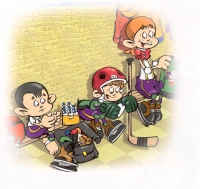 Next to buying a house or a car, likely the next largest cost to a parent is having a child playing
hockey. That financial cost, from the child's perspective, becomes the subject matter of Brady
Brady and the Great Exchange. Brady has noticed that Gregory always stays behind in the
dressing room as all the other Icehogs take to the ice. Brady just attributes Gregory's behaviour
to its being a superstition in the same fashion that Brady always had to be the first one at the rink
or that Chester always ate popcorn before games. However, one day when Brady returns to the
dressing room to retrieve a forgotten item, he discovers the real reason for Gregory's lagging
behind: "My skates don't fit me any more and my parents can't buy me new ones right now. It
hurts to skate." Brady comes up with both an immediate and a long term solution, the latter being
"the biggest equipment exchange ever!" Held in Brady's backyard rink, the exchange is a success
for all, not just Gregory. Next to buying a house or a car, likely the next largest cost to a parent is having a child playing
hockey. That financial cost, from the child's perspective, becomes the subject matter of Brady
Brady and the Great Exchange. Brady has noticed that Gregory always stays behind in the
dressing room as all the other Icehogs take to the ice. Brady just attributes Gregory's behaviour
to its being a superstition in the same fashion that Brady always had to be the first one at the rink
or that Chester always ate popcorn before games. However, one day when Brady returns to the
dressing room to retrieve a forgotten item, he discovers the real reason for Gregory's lagging
behind: "My skates don't fit me any more and my parents can't buy me new ones right now. It
hurts to skate." Brady comes up with both an immediate and a long term solution, the latter being
"the biggest equipment exchange ever!" Held in Brady's backyard rink, the exchange is a success
for all, not just Gregory.
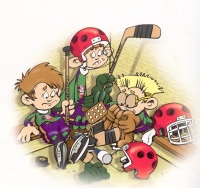 Being a child is largely about becoming because so much of life is ahead of you, rather than
behind. And, while playing hockey is, in itself, fun, there are moments that seem to be more
significant than others. In the case of Brady and his fellow Icehogs, the next significant event is
"the biggest hockey tournament of the season, the Gold Stick." In Brady Brady and the Most
Important Game, the Icehogs meet the Dragoons in the final game of the tournament. The
Dragoons play a dirty brand of hockey, and their coach, intent on winning, "played his best
players most of the game. Some Dragoons did not get to play at all." On the other hand, the
Icehogs' coach said, "We made it here as a team, and everyone on the team will play." The
schoolyard chant, "Cheaters never prosper," is not confirmed as the Dragoons win and the
Icehogs head to the dressing room where "tears rolled down several Icehogs' faces." However,
their coach is not disappointed and commends them for how hard they played to get to the final
game. While the message he delivers to his young players is absolutely valid, it is perhaps too
didactically worded: "And if you learn only one thing in your hockey lives, remember this, it's
more important to lose fairly, than to win by cheating." Like all of the Brady Brady books, this
one has a happy ending with the Icehogs' moms and dads playing against their children in a fun
game. Being a child is largely about becoming because so much of life is ahead of you, rather than
behind. And, while playing hockey is, in itself, fun, there are moments that seem to be more
significant than others. In the case of Brady and his fellow Icehogs, the next significant event is
"the biggest hockey tournament of the season, the Gold Stick." In Brady Brady and the Most
Important Game, the Icehogs meet the Dragoons in the final game of the tournament. The
Dragoons play a dirty brand of hockey, and their coach, intent on winning, "played his best
players most of the game. Some Dragoons did not get to play at all." On the other hand, the
Icehogs' coach said, "We made it here as a team, and everyone on the team will play." The
schoolyard chant, "Cheaters never prosper," is not confirmed as the Dragoons win and the
Icehogs head to the dressing room where "tears rolled down several Icehogs' faces." However,
their coach is not disappointed and commends them for how hard they played to get to the final
game. While the message he delivers to his young players is absolutely valid, it is perhaps too
didactically worded: "And if you learn only one thing in your hockey lives, remember this, it's
more important to lose fairly, than to win by cheating." Like all of the Brady Brady books, this
one has a happy ending with the Icehogs' moms and dads playing against their children in a fun
game.
While each Brady Brady volume can stand alone as a separate read, children who have read (or
had read to them) earlier books in the series will be able to bring some greater understandings to
later books. For example, if before reading Brady Brady and the Most Important Game,
children have encountered Brady Brady and the Singing Tree, they will recognize the
significance of Tree's singing the anthem before the opening game of the Gold Stick tournament
while those who have met Brady Brady and the Runaway Goalie will immediately understand
why, following the Icehogs' learning that they were to play the Dragoons, "Brady tied Chester's
skates together so that he couldn't run away."
Temple's bright cartoon-style illustrations not only complement Shaw's text but appropriately
extend it, especially in his addition of little details, such as the pucks' black scuff marks on the
rink's boards both in Brady Brady and the Great Exchange and Brady Brady and the Big
Mistake or the unlit/lit streetlights which subtly indicate the passage of time as the children
search for the puck in Brady Brady and the Big Mistake. As well, Temple's facial
expressions on his characters reinforce the emotions described in the text, and his occasional use
of Hatrick as emotional counterpoint is effective. For example, on the cover of Brady Brady and
the Big Mistake, Brady can be seen poised before his father's puck, a look of uncertainty on his
face, while Hatrick looks out at the readers in such a doleful fashion that readers can almost
anticipate that something bad is going to happen. As noted earlier, Temple also uses the
closing illustration to tie up the books' contents. However, for young readers, perhaps the final
illustration in Brady Brady and the Most Important Game may be the most challenging for them
to understand. In the foreground, the Icehogs and their parents are obviously having fun playing
against each other, the children having already seemingly forgotten their loss. The background
reveals the parentless, winning Dragoons, with sad looks on their faces, sitting in the stands, their
trophy and equipment stacked up. Given that Shaw's text had said that, during the game, "Brady
could see the Dragoons fans in the stands whistling and screaming at the top of their lungs," the
adults' absence at this point is difficult to comprehend.
Nonetheless, these three "Brady Brady" titles are well worth being added to home collections and
libraries serving preschool and early years children.
Highly Recommended.
Dave Jenkinson teaches courses in children's and adolescent literature in the Faculty of
Education, the University of Manitoba.

To comment
on this title or this review, send mail to cm@umanitoba.ca.
Copyright © the Manitoba Library Association. Reproduction for personal
use is permitted only if this copyright notice is maintained. Any
other reproduction is prohibited without permission.
NEXT REVIEW |
TABLE OF CONTENTS FOR THIS ISSUE
- February 4, 2005.
AUTHORS |
TITLES |
MEDIA REVIEWS |
PROFILES |
BACK ISSUES |
SEARCH |
CMARCHIVE |
HOME |



 Brady Brady had played only a few periods of hockey when his publisher, Stoddart, went out of
business, but now he and his fellow Icehogs are back on the ice with their own publishing house,
Brady Brady Inc. As in the earlier Stoddart volumes, Brady and his teammates are dealing with
matters than loom large in the minds of young children. In Brady Brady and the Big Mistake,
Brady, without permission, borrows his father's treasured possession, a puck autographed by the
legendary Bobby Orr. While it was initially only Brady's intention to show the puck to his friends,
it becomes the one they use in a game of shinny on Brady's backyard rink. Unfortunately, Brady's
wrist shot flies over the net, and the puck disappears into a huge snowbank. Everyone searches
for the puck but with no success, and, when Brady's father comes home, the young lad must
confess what he has done. Although Brady's father does express some disappointment in his son's
initial action, he expresses his pride in Brady's "telling me the truth about what happened." While
the text doesn't say so directly, the book has a happy ending for Temple's closing illustration
shows Hatrick, Brady's dog, standing in his doghouse, the missing puck clamped in his jaws.
Brady Brady had played only a few periods of hockey when his publisher, Stoddart, went out of
business, but now he and his fellow Icehogs are back on the ice with their own publishing house,
Brady Brady Inc. As in the earlier Stoddart volumes, Brady and his teammates are dealing with
matters than loom large in the minds of young children. In Brady Brady and the Big Mistake,
Brady, without permission, borrows his father's treasured possession, a puck autographed by the
legendary Bobby Orr. While it was initially only Brady's intention to show the puck to his friends,
it becomes the one they use in a game of shinny on Brady's backyard rink. Unfortunately, Brady's
wrist shot flies over the net, and the puck disappears into a huge snowbank. Everyone searches
for the puck but with no success, and, when Brady's father comes home, the young lad must
confess what he has done. Although Brady's father does express some disappointment in his son's
initial action, he expresses his pride in Brady's "telling me the truth about what happened." While
the text doesn't say so directly, the book has a happy ending for Temple's closing illustration
shows Hatrick, Brady's dog, standing in his doghouse, the missing puck clamped in his jaws.
 Next to buying a house or a car, likely the next largest cost to a parent is having a child playing
hockey. That financial cost, from the child's perspective, becomes the subject matter of Brady
Brady and the Great Exchange. Brady has noticed that Gregory always stays behind in the
dressing room as all the other Icehogs take to the ice. Brady just attributes Gregory's behaviour
to its being a superstition in the same fashion that Brady always had to be the first one at the rink
or that Chester always ate popcorn before games. However, one day when Brady returns to the
dressing room to retrieve a forgotten item, he discovers the real reason for Gregory's lagging
behind: "My skates don't fit me any more and my parents can't buy me new ones right now. It
hurts to skate." Brady comes up with both an immediate and a long term solution, the latter being
"the biggest equipment exchange ever!" Held in Brady's backyard rink, the exchange is a success
for all, not just Gregory.
Next to buying a house or a car, likely the next largest cost to a parent is having a child playing
hockey. That financial cost, from the child's perspective, becomes the subject matter of Brady
Brady and the Great Exchange. Brady has noticed that Gregory always stays behind in the
dressing room as all the other Icehogs take to the ice. Brady just attributes Gregory's behaviour
to its being a superstition in the same fashion that Brady always had to be the first one at the rink
or that Chester always ate popcorn before games. However, one day when Brady returns to the
dressing room to retrieve a forgotten item, he discovers the real reason for Gregory's lagging
behind: "My skates don't fit me any more and my parents can't buy me new ones right now. It
hurts to skate." Brady comes up with both an immediate and a long term solution, the latter being
"the biggest equipment exchange ever!" Held in Brady's backyard rink, the exchange is a success
for all, not just Gregory. Being a child is largely about becoming because so much of life is ahead of you, rather than
behind. And, while playing hockey is, in itself, fun, there are moments that seem to be more
significant than others. In the case of Brady and his fellow Icehogs, the next significant event is
"the biggest hockey tournament of the season, the Gold Stick." In Brady Brady and the Most
Important Game, the Icehogs meet the Dragoons in the final game of the tournament. The
Dragoons play a dirty brand of hockey, and their coach, intent on winning, "played his best
players most of the game. Some Dragoons did not get to play at all." On the other hand, the
Icehogs' coach said, "We made it here as a team, and everyone on the team will play." The
schoolyard chant, "Cheaters never prosper," is not confirmed as the Dragoons win and the
Icehogs head to the dressing room where "tears rolled down several Icehogs' faces." However,
their coach is not disappointed and commends them for how hard they played to get to the final
game. While the message he delivers to his young players is absolutely valid, it is perhaps too
didactically worded: "And if you learn only one thing in your hockey lives, remember this, it's
more important to lose fairly, than to win by cheating." Like all of the Brady Brady books, this
one has a happy ending with the Icehogs' moms and dads playing against their children in a fun
game.
Being a child is largely about becoming because so much of life is ahead of you, rather than
behind. And, while playing hockey is, in itself, fun, there are moments that seem to be more
significant than others. In the case of Brady and his fellow Icehogs, the next significant event is
"the biggest hockey tournament of the season, the Gold Stick." In Brady Brady and the Most
Important Game, the Icehogs meet the Dragoons in the final game of the tournament. The
Dragoons play a dirty brand of hockey, and their coach, intent on winning, "played his best
players most of the game. Some Dragoons did not get to play at all." On the other hand, the
Icehogs' coach said, "We made it here as a team, and everyone on the team will play." The
schoolyard chant, "Cheaters never prosper," is not confirmed as the Dragoons win and the
Icehogs head to the dressing room where "tears rolled down several Icehogs' faces." However,
their coach is not disappointed and commends them for how hard they played to get to the final
game. While the message he delivers to his young players is absolutely valid, it is perhaps too
didactically worded: "And if you learn only one thing in your hockey lives, remember this, it's
more important to lose fairly, than to win by cheating." Like all of the Brady Brady books, this
one has a happy ending with the Icehogs' moms and dads playing against their children in a fun
game.